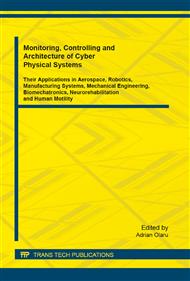[1]
N. Vieru, Manual of sports gymnastics, Driada, Publishing House, (1997) 14, 182-197.
Google Scholar
[2]
L. Ja. Arkaev, N.G. Suchilin, Kak gotovit' chempionov. Teorija i tehnologija podgotovki gimnastov vyshej kvalifikacii. Fizkul'tura i sport. Moskva, 2004, pp.22-24.
Google Scholar
[3]
V.M. Smolevskij, Ju.K., Gaverdovskij, Sportivnaja gimnastika. Olimpijskaja literature, Kiev, 1999, pp.112-121, 168-189.
Google Scholar
[4]
Grigore, V. (2001). Artistic gymnastics: theoretical fundamentals of sports training. Bucharest: Semne, Publishing House, 81.
Google Scholar
[5]
A. Dragnea, S. Mate- Teodorescu, Theory of Sport. FEST Publishing House, Bucharest, 2002. p.106.
Google Scholar
[6]
V.N. Platonov, Sistema podgotovki sportsmenov v olimpijskom sporte: obwaja teorija i ee prakticheskie prilozhenijaju. Olimptjskaja literatura, Kiev, 2004, pp.301-315.
Google Scholar
[7]
M. Bibire, T. Dobrescu, Uneven bars – concept and modern methodologies. PIM Publishing House, Iasi, 2008, pp.79-95.
Google Scholar
[8]
F.E. Grosu, Uneven bars in women's artistic gymnastics. Gymnastics, Vol. 1, GMI Publishing House, Cluj-Napoca, 2004, p.21.
Google Scholar
[9]
Code Of Points Women's Artistic Gymnastics, Fédération Internationale de Gymnastique, Part III, section 11 – uneven bars, article 11, 2013, pp.41-43, 70-103.
Google Scholar
[10]
R. Manno, Les bases de l'entraînement sportif, Edition Revue EPS, Paris, 1992, p.152.
Google Scholar
[11]
M. Ifrim, Motor anthropology. Scientific and Encyclopedic Publishing House, Bucharest, (1986).
Google Scholar
[12]
D.D. Donskoi, Biomechanics of physical exercises, Youth Publishing House, Bucharest, (1973).
Google Scholar
[13]
M. Crețu, I.I. Simăn, M. Bărbulescu, Biomechanics of back giant on uneven bars. Publishing House of Pitești University, 2004, pp.12-23.
Google Scholar
[14]
V. Potop, Adjustment of Motor Behavior in Women's Artistic Gymnastics by Biomechanical Study of Technique. Bren, Publishing House, Bucharest, 2007, pp.140-144.
Google Scholar
[15]
N.G. Suchilin, Gimnastika: teorija i praktika: metodicheskoe prilozhenie k zhurnalu «Gimnastika». Federacija sportivnoj gimnastiki Rossii. –Vyp. 1. Sovetskij sport, Moskva. 2010, pp.5-13.
Google Scholar
[16]
A. Gagea, Analytical biomechanics. UNEFS, Bucharest, 2006, pp.148-157.
Google Scholar
[17]
G.P. Bruggmann, Biomechanics of gymnastics technique. Sport Science Review, vol 3, 1994, pp.79-120.
Google Scholar
[18]
Ju.K. Gaverdovskij. Obuchenie sportivnym uprazhnenijam. Biomehanika. Metodologija. Didaktika. Fizkul'tura i sport, Moskva, 2007, pp.175-192.
Google Scholar
[19]
V. Potop, Motor learning and transfer in performance artistic gymnastics. Debridge Press, New York, 2007, pp.75-150.
Google Scholar
[20]
V.N. Boloban, Sistema obuchenija dvizhenijam v slozhnyh uslovijah podderzhanija statodinamicheskoj ustojchivosti. Avtoreferat dissertacii na soiskanie uchenoj stepeni doktora pedagogicheskih nauk. Kiev, 1990, pp.14-17.
Google Scholar
[21]
V. Potop, W. Grigore, S. Marinescu, Motor learning gymnastics exercises on the basis of transfer technologies. Science in the Olympic sports, 1, (2012). 47-57.
Google Scholar
[22]
V.N. Boloban, Regulation of body posture athlete. NUPESU Olympic literature, Kiev, (2013).
Google Scholar
[23]
V. Potop, R. Grad, V. Boloban, Biomechanical indicators of key elements sport equipment gymnastics exercises. Pedagogies, psychology, medical-biological problems of physical training and sport, vol. 9, 2013, pp.59-72.
Google Scholar
[24]
V. Potop, Methodology of Motor Learning Based on Transfer Technology in Women's Artistic Gymnastics. Medimond International Proceedings Division. Monduzzi editore, Printed in December 2013 by Editografica Bologna (Italy), pp.285-288.
Google Scholar
[25]
V. Potop, Learning and Transfer in Women's Artistic Gymnastics. Procedia - Social and Behavioral Sciences. Volume 93, 21 October 2013, p.23–28.
Google Scholar
[26]
V. Potop, Biomechanical Analysis of Sports Technique Key Elements in Back Double Somersault Dismount off Uneven Bars-Junior Gymnasts 12 to 14 Years Old. Procedia - Social and Behavioral Sciences, Volume 117, 19 March 2014, p.203–209.
DOI: 10.1016/j.sbspro.2014.02.202
Google Scholar


